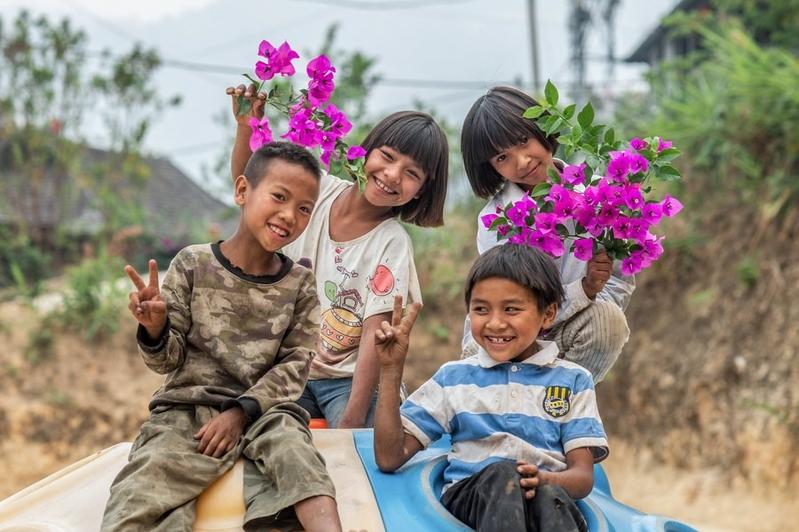 Kids of the Lahu ethnic group pose for a photo in a hamlet of Bulangshan Township in Menghai County, southwest China's Yunnan Province, April 9, 2020. (HU CHAO / XINHUA)
Kids of the Lahu ethnic group pose for a photo in a hamlet of Bulangshan Township in Menghai County, southwest China's Yunnan Province, April 9, 2020. (HU CHAO / XINHUA)
KUNMING — Bai Shulin, 70, immediately recognized the naked little boy in the black- and-white documentary footage he was watching. It was him, at the age of 6. The young Bai in the footage was carrying a bamboo basket on his back, surrounded by wild woods and half-naked adults clothed with banana leaves.
The video clips jogged Bai's memory, taking him back 64 years to when he and his Kucong peers left the deep mountains for the first time.
At last, everything went smoothly and people no longer wanted to go back to living in banana leaf-covered huts.
Bai Shulin, a Kucong villager in Yunnan province
Kucong ethnic people, an offshoot of the Lahu ethnic group, used to live a primitive life in the mountainous regions of Southwest China's Yunnan province. Yunnan now boasts 30,000 Kucong people, mainly living in the Ailao Mountain area in Zhenyuan and Jinping counties.
A local poet describes traditional Kucong life as being "children left in the dense forest" and "people wearing furs and leaves, eating wild fruit and living in a hut covered with banana leaves, which failed to provide shelter from the wind and rain".
"When I was a child, a piece of squirrel meat could be all I had to eat for a whole day, and roasted banana leaves were often used to wrap a baby after birth," Bai says.
Since the 1950s, supportive policies targeting impoverished ethnic groups have helped relocate Kucong people to modern communities, with 3,739 Kucong people moving out of the mountains in Jinping county in the 1950s and '60s. However, many of them returned to the mountains after finding themselves unaccustomed to the climate and living habits elsewhere.
Bai's village is also known as "Liuban village", which in Chinese literally means that the village has relocated six times. It can be found in Zhemi Lahu ethnic township, Jinping county, near the southern end of Ailao Mountain.
Bai became head of the village in 1968 and started the journey of leading the villagers out of the mountains, and did so four times.
With the assistance of the government, villagers finally settled at Laolinjiao village in 2009, and this location offered them better conditions.
"Local authorities built cement houses for us and officials taught us the latest production techniques," Bai says. "At last, everything went smoothly and people no longer wanted to go back to living in banana leaf-covered huts."
Gradually, Kucong people learned to grow rice, bananas and rubber. In recent years, they also started to plant macadamia nuts and herbal medicine crops.
The booming development of various industries has brought fortune to Kucong people and Bai's village has been renamed Anfu village, which means "stability and happiness" in Chinese.
"Compared with the past, Kucong people have strived hard to work for a better life in recent years," says Wang Qiujie, head of Zhemi Lahu ethnic township that administers Anfu village.
Bai Longfa, the grandson of Bai Shulin, recently found the Kucong documentary while surfing the internet with a 5G cellphone, and was thrilled to share it with the whole family.
"Great changes have taken place in the village," says Bai Longfa. "When I was young, there was not even a toilet in the village. People would always go to a hidden corner in the woods."
The availability of the 5G network in the village has facilitated the junior Bai's dream of developing more businesses. "I've seen a lot of agricultural products selling well on livestreaming platforms and I also want to jump on this bandwagon," Bai Longfa says, adding that he has talked with some villagers about it, and they think it is worth trying.
In his spare time, Bai Longfa likes to drive his car to the provincial capital Kunming to purchase goods for the clothing store he runs in the village. He always takes pictures of the scenery on the 5-hour journey and shares them on WeChat.
"Many of my friends like the pictures, and we have agreed to travel to more places in the future," he says.


